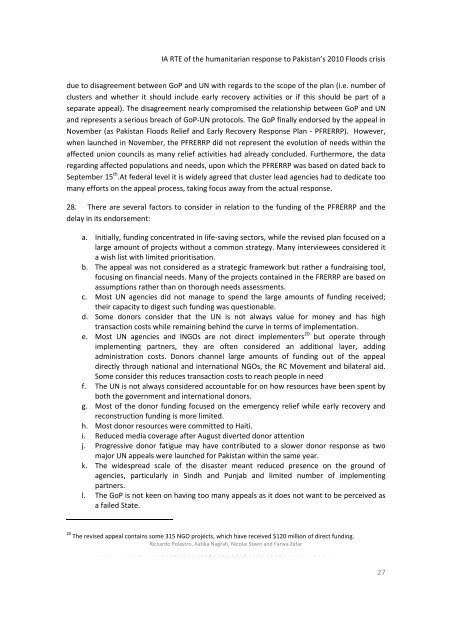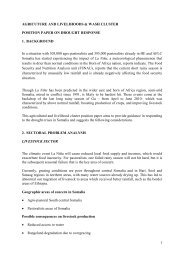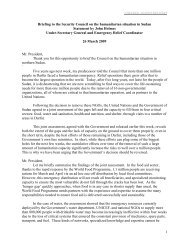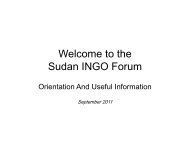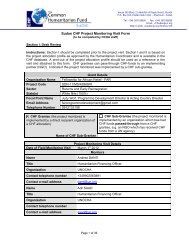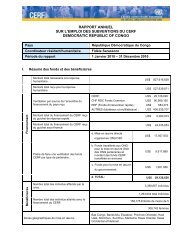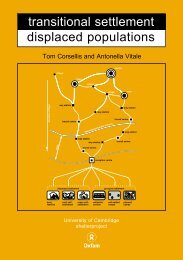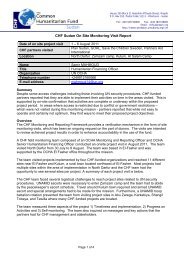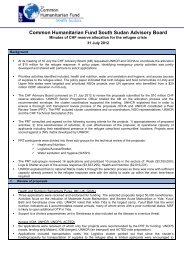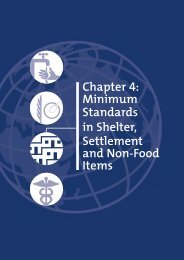Inter-Agency Real Time Evaluation of the Humanitarian ... - OCHANet
Inter-Agency Real Time Evaluation of the Humanitarian ... - OCHANet
Inter-Agency Real Time Evaluation of the Humanitarian ... - OCHANet
You also want an ePaper? Increase the reach of your titles
YUMPU automatically turns print PDFs into web optimized ePapers that Google loves.
IA RTE <strong>of</strong> <strong>the</strong> humanitarian response to Pakistan’s 2010 Floods crisis<br />
due to disagreement between GoP and UN with regards to <strong>the</strong> scope <strong>of</strong> <strong>the</strong> plan (i.e. number <strong>of</strong><br />
clusters and whe<strong>the</strong>r it should include early recovery activities or if this should be part <strong>of</strong> a<br />
separate appeal). The disagreement nearly compromised <strong>the</strong> relationship between GoP and UN<br />
and represents a serious breach <strong>of</strong> GoP‐UN protocols. The GoP finally endorsed by <strong>the</strong> appeal in<br />
November (as Pakistan Floods Relief and Early Recovery Response Plan ‐ PFRERRP). However,<br />
when launched in November, <strong>the</strong> PFRERRP did not represent <strong>the</strong> evolution <strong>of</strong> needs within <strong>the</strong><br />
affected union councils as many relief activities had already concluded. Fur<strong>the</strong>rmore, <strong>the</strong> data<br />
regarding affected populations and needs, upon which <strong>the</strong> PFRERRP was based on dated back to<br />
September 15 th .At federal level it is widely agreed that cluster lead agencies had to dedicate too<br />
many efforts on <strong>the</strong> appeal process, taking focus away from <strong>the</strong> actual response.<br />
28. There are several factors to consider in relation to <strong>the</strong> funding <strong>of</strong> <strong>the</strong> PFRERRP and <strong>the</strong><br />
delay in its endorsement:<br />
a. Initially, funding concentrated in life‐saving sectors, while <strong>the</strong> revised plan focused on a<br />
large amount <strong>of</strong> projects without a common strategy. Many interviewees considered it<br />
a wish list with limited prioritisation.<br />
b. The appeal was not considered as a strategic framework but ra<strong>the</strong>r a fundraising tool,<br />
focusing on financial needs. Many <strong>of</strong> <strong>the</strong> projects contained in <strong>the</strong> FRERRP are based on<br />
assumptions ra<strong>the</strong>r than on thorough needs assessments.<br />
c. Most UN agencies did not manage to spend <strong>the</strong> large amounts <strong>of</strong> funding received;<br />
<strong>the</strong>ir capacity to digest such funding was questionable.<br />
d. Some donors consider that <strong>the</strong> UN is not always value for money and has high<br />
transaction costs while remaining behind <strong>the</strong> curve in terms <strong>of</strong> implementation.<br />
e. Most UN agencies and INGOs are not direct implementers 20 but operate through<br />
implementing partners, <strong>the</strong>y are <strong>of</strong>ten considered an additional layer, adding<br />
administration costs. Donors channel large amounts <strong>of</strong> funding out <strong>of</strong> <strong>the</strong> appeal<br />
directly through national and international NGOs, <strong>the</strong> RC Movement and bilateral aid.<br />
Some consider this reduces transaction costs to reach people in need<br />
f. The UN is not always considered accountable for on how resources have been spent by<br />
both <strong>the</strong> government and international donors.<br />
g. Most <strong>of</strong> <strong>the</strong> donor funding focused on <strong>the</strong> emergency relief while early recovery and<br />
reconstruction funding is more limited.<br />
h. Most donor resources were committed to Haiti.<br />
i. Reduced media coverage after August diverted donor attention<br />
j. Progressive donor fatigue may have contributed to a slower donor response as two<br />
major UN appeals were launched for Pakistan within <strong>the</strong> same year.<br />
k. The widespread scale <strong>of</strong> <strong>the</strong> disaster meant reduced presence on <strong>the</strong> ground <strong>of</strong><br />
agencies, particularly in Sindh and Punjab and limited number <strong>of</strong> implementing<br />
partners.<br />
l. The GoP is not keen on having too many appeals as it does not want to be perceived as<br />
a failed State.<br />
20<br />
The revised appeal contains some 315 NGO projects, which have received $120 million <strong>of</strong> direct funding.<br />
Riccardo Polastro, Aatika Nagrah, Nicolai Steen and Farwa Zafar<br />
27


